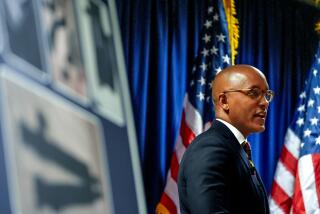Blockbuster CEO Jim Keyes still sees movie-rental opportunities
Once the dominant renter of videotapes and DVDs with a presence on seemingly every street corner, Blockbuster Inc. is in the throes of closing more than 1,000 stores while its stock trades at 30 cents a share.
The reasons are evident in the red envelopes that appear in people’s home mailboxes every day and in the ubiquitous red kiosks popping up in grocery stores across the country.
But Netflix and Redbox aren’t the only challenges faced by Blockbuster Chief Executive Jim Keyes since he joined the Dallas company in 2007. A crushing debt load that the retailer spent much of 2009 renegotiating distracted senior management and constrained the company’s ability to invest in inventory and marketing.
Last year Blockbuster’s loss grew 49% to $558.2 million, while revenue plunged by $1 billion to $4.06 billion.
Blockbuster perseveres, however, by focusing on its ability to offer movies the same day they go on sale in stores and by mail, whereas Netflix and Redbox have made deals with certain studios not to make titles available until four weeks after they are released on DVD. The companyis also working with vending machine partner NCR Corp.to deploy 10,000 Blockbuster-branded rental kiosks in retail locations by the end of this year.
Keyes spoke to Facetime about what opportunities remain for a down-but-not-out Blockbuster amid radical changes in the home entertainment business.
Blockbuster stores are shutting down rapidly all around the world. In the age of Netflix, Redbox and digital distribution, do people still want to drive to a store to rent a DVD?
Absolutely. Stores were once a convenience and that’s why we had so many. That has now been supplanted by two other even more convenient forms of access, which means the role of the store is changing from the most convenient place to get DVDs to a retail entertainment destination.
Here’s an analogy: If I want to buy an obscure book title, I’ll go to Amazon.com. But if I want to browse and see what’s new, I will go to Barnes & Noble.
You have recently renewed your new-release deals with Warner Bros., 20th Century Fox and Sony Pictures at the same time that Warner, Fox and Universal Pictures have gotten Netflix to agree to a 28-day delay for new releases. How does that impact your business?
These new agreements with Netflix represent a breakthrough in rationalizing the distribution chain so that subscription has its appropriate place. Historically, subscription services like HBO had a window. Then that was disrupted because the “first-sale doctrine” gave newcomers the capability to rent them via subscription outside of the traditional window.
Blockbuster can restore consumer relevance because we do carry new releases, and in fact our recent agreements give us the privilege of day-and-date content across our channel, which we believe is a strong competitive advantage.
What about your kiosks? Redbox agreed to a 28-day window with Warner Bros. Can you keep offering movies for $1 per night the day they go on sale?
We’re working on that. The difference in our kiosks versus Redbox’s is that they are an extension of the store. We don’t think of vending as a stand-alone business. They will be an extension of the store with return capabilities from kiosk to store and vice versa. More importantly, the distribution efficiencies of stores and kiosks managing inventory will mean they’re never out of stock.
Also in contrast to Redbox, we see our kiosk strategy as a steppingstone to digital downloads, which would likely be at the same price as video on demand. New releases at [higher] VOD pricing is a very different economic model than the one currently deployed by Redbox.
Your “Blockbuster-on-Demand” digital service makes consumers pay to download each movie. Isn’t that less convenient than Netflix’s service letting people stream as many movies as they want for one monthly price?
You tell me: Do you want to watch “The Blind Side” or “Herbie Goes to Cancun”? Netflix has a wonderful Internet service for older titles and television. Our customer demand is 60% to 80% for new releases. The subscription model does not translate effectively to what our customers want to see when they want to see them.
What’s the last movie you watched at home and how did you get it?
The last movie I rented was “Sherlock Holmes,” which I got in a store and really liked.
My wife has become a big customer of Blockbuster-on-Demand because her mother is in town and they’re staying busy watching two movies per night by just pushing a button on the remote control.
More to Read
The biggest entertainment stories
Get our big stories about Hollywood, film, television, music, arts, culture and more right in your inbox as soon as they publish.
You may occasionally receive promotional content from the Los Angeles Times.










